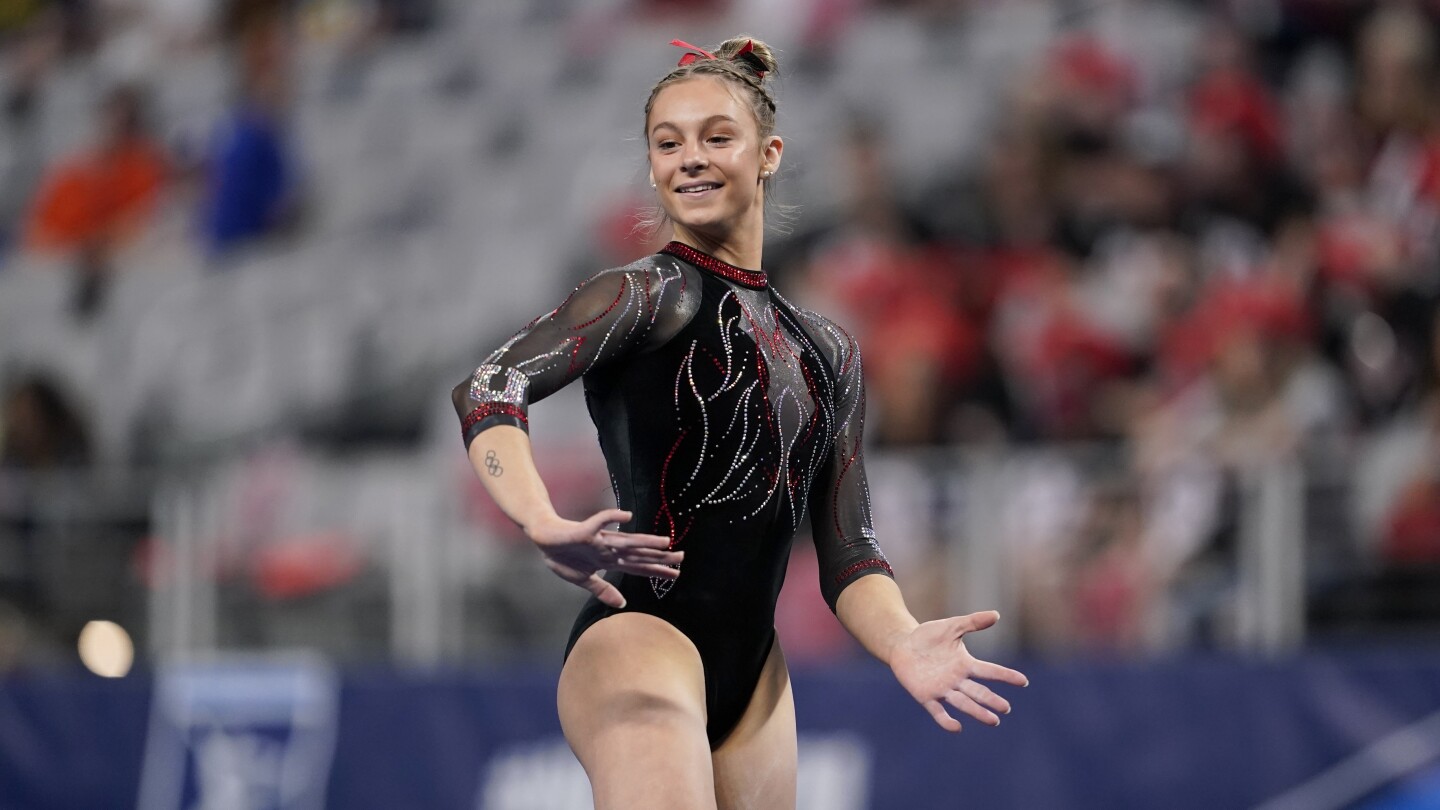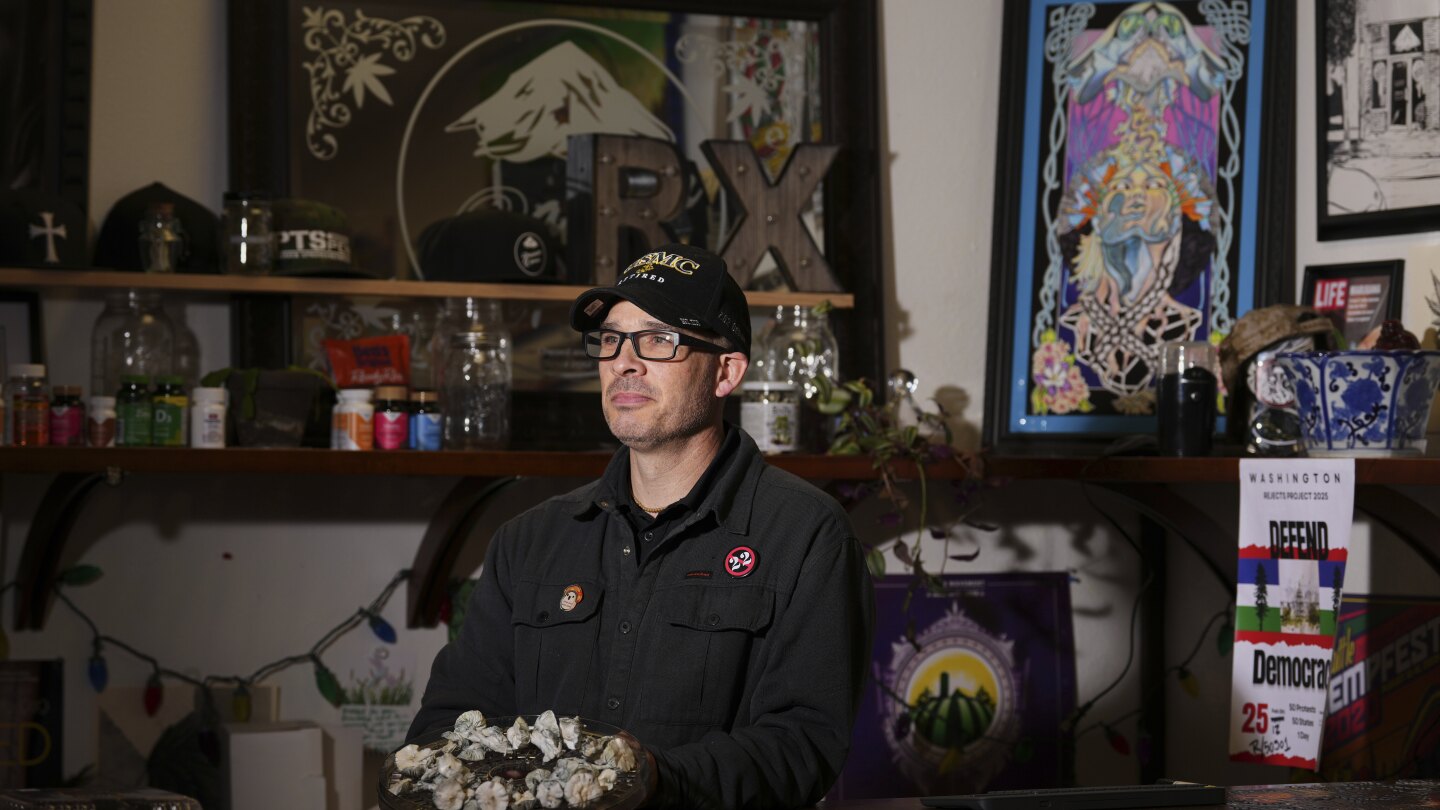Lifestyle
King Charles III and Queen Camilla reach their 20th wedding anniversary

LONDON (AP) — It was a fairy tale romance.
There was the lavish royal wedding. A kiss on the balcony of Buckingham Palace. Cheers from the adoring throngs below.
Wait! That’s the wrong story. The right one is much more, well, complicated.
King Charles III and Queen Camilla met more than 50 years ago but their romance had to survive meddling families, marriages to other people and no small amount of public ridicule before they finally married. On Wednesday, the royal couple celebrate their 20th anniversary, a milestone made all the more remarkable by the fact that for so long their love story was overshadowed by the fairy tale princess who came before Camilla.
“We missed the love story, there’s no doubt about it,’’ said Sally Bedell Smith, author of “Prince Charles: The Passions and Paradoxes of an Improbable Life.’’ “But in fairness, it was not something that was very visible.”
It’s a long story
The road between the time they met in the 1970s and their marriage on April 9, 2005, was rocky.
Charles, then a young naval officer, fell in love but was soon sent to sea for eight months. While he was away, Camilla accepted the proposal of a dashing cavalry officer.
But they remained friends, even as Charles’ courtship and marriage to Lady Diana Spencer played out before an adoring nation in 1981. And they were more than friends when both of their marriages crumbled in the mid-1990s.
Many in Britain blamed Camilla for the extramarital affair that torpedoed his marriage to Diana, the glamorous young mother of Princes William and Harry who was adored for her style and the human touch she brought to her charity work. That resentment flared when “the People’s Princess” died in a Paris car crash in 1997, five years after her messy, public split from Charles.
The crash thrust Camilla back into the shadows.
Over time, she was slowly reintroduced to the public, starting with a 1999 event where she and Charles made their first public appearance as a couple. There were meetings with Queen Elizabeth II, as well as with William and Harry.
Still, there were questions. Should a divorced man be king? Could Camilla ever be queen?
But eventually the time was right.
A quiet wedding
The union came on April 9, 2005, in a modest civil ceremony in Windsor — just down the road from the 1,000-year-old castle that is a second home for British royals. Instead of the pageantry that marked Charles’ wedding to Diana — an extravaganza watched by millions around the world — Britain got a union between 50-something divorcees.
The bride wore a cream silk chiffon dress and matching coat, with a lace-trimmed straw hat. The groom wore a black tailcoat and gray tie. William and Harry attended, as did Camilla’s two children. In total, there were 30 guests.
A blessing ceremony at the castle’s St. George’s Chapel later that day was attended by 800 people, including the groom’s parents, Elizabeth and Prince Philip.
There were a few boos from the crowd — presumably from Diana fans — but mostly cheers. One banner read: “Let he who is without sin cast the first stone.”
There were waves, but no kiss.
A lasting union
Their union has now lasted five years longer than Charles’ marriage to Diana and shows no signs of faltering.
Julie Gottman, co-founder of The Gottman Institute, which studies relationships, said Charles and Camilla appear to embody many of the characteristics needed for a strong marriage: trust, commitment and a sense of shared purpose.
“Before anything, they had a friendship,” she said. “And when you have a relationship in which friendship is the foundation, you’re much more likely to really succeed in marriage and a committed relationship because that foundation is already there.”
The public mood has continued to soften in the years since Charles married the woman then known as Camilla Parker Bowles.
Camilla, 77, has taken on roles at almost 100 charities, championing issues that range from promoting literacy to supporting victims of domestic violence and fighting child sexual exploitation. Some of her causes pushed the boundaries of the royal family, known for supporting worthy but non-controversial charities. For the public, it seemed as if she was in touch with the modern world.
Her style is down to earth. Her sense of humor is self-deprecating. Just like Charles, she loves dogs and horses. More to the point, she seems to make the king happy.
Strength and stay
George Gross, a royal historian at King’s College London, said the relationship reminds him of that between Charles’ parents. Elizabeth described Philip as her “strength and stay’’ in her Golden Wedding anniversary speech, recognizing his unwavering support and partnership throughout their 70-year marriage and her long reign.
“I think they have managed to find this way of making it work, and I do think feeding off each other in this strength of resilience, because I think you have to be resilient and if you count the number of, in fact it’s very difficult to count, the number of engagements they do every year multiplied by those 20 years of marriage, it’s thousands,” Gross said.
The relationship has been further challenged by Charles’ cancer diagnosis. The king briefly cancelled his public engagements for more than two months last year after revealing that he was undergoing treatment for an undisclosed form of cancer.
Camilla stepped lightly into the void, increasing her appearances and taking on the all-important role of keeping the royal family in the public eye. Camilla has helped pick up the slack, demonstrating the importance of her rehabilitation to Charles and the royal family.
And when Charles resumed his duties, Camilla took a few steps back. Not into the shadows, exactly, but far enough to make sure that the spotlight shined on Charles.
That suggests something else about Camilla that helped make the relationship a success, Gottman said.
“My guess is that … it wasn’t about becoming queen,” she said. “That wasn’t it. What she wanted all along was to be his true love and mate.’’
Lifestyle
Picking a team from bars to beam and hoping for 10s: Fantasy leagues in gymnastics are a thing

WASHINGTON (AP) — Thomas Bateman kept busy this year managing college fantasy teams in 12 different leagues, a lineup that included SECret Weapon and One and Dunne. Five of them won it all.
These were not teams stocked with NFL or NBA players. All 12 were made up of college gymnasts, and the Chicago-based marriage and family therapist is just one member of a fervent and growing fan base that channels their love of the sport into fantasy leagues.
“It’s such a great way to get to know the sport a bit,” Bateman said. “When I started off, I got these lists from College Gym News and picked athletes I didn’t really know, so then I got to know teams I liked and then got familiar with athletes I want to draft. It’s a great way to potentially grow the audience of the sport.”
Interest in gymnastics traditionally peaks with the Olympic cycle, but on the “gymternet” – the online global community for devoted fans – it’s a year-round sport. At the college level, major growth in name, image and likeness deals, viewership and streaming availability has been accompanied by a surge in fantasy leagues, too.
This year, over 7,000 women’s college gymnastics devotees have found their way to the Gymlytics and GymCastic fantasy platforms — all within the last few years.
From the Olympics to NCAA
Gymlytics, which launched before the 2022 collegiate season, runs through the regular season and has a postseason bracket competition. GymCastic, in its second year, offers weekly fantasy matchups, including the NCAA postseason and elite meets later in the year.
The two leagues take slightly different approaches. Gymlytics participants draft individual athletes for their team at the beginning of the season and set lineups for each week of competition. GymCastic runs a salary cap-style draft, in which athletes are valued at a certain number of “gym rubles.” Participants select athletes until their roster is filled while staying under the cap.
Neither are the first platforms of their kind: Founders of both pointed to Kristen Watkins, a former college gymnast and self-taught programmer who created and ran College Fantasy Gymnastics for the decade leading into the pandemic-canceled 2020 season, as an inspiration.
Watkins competed for the MIT gymnastics team until it was cut following the 2009 season, a period in which other college gymnastics programs were cut or coming under threat of reduction. The creation of the fantasy league, she said, was motivated in part because she wanted to see if there could be more interest in women’s gymnastics.
Subsequent leagues have hinged on the same idea.
“That’s the point of everything we do: It’s very, very specific to the gymnastics fans,” said Jessica O’Beirne, creator of the popular GymCastic podcast and a co-founder of the fantasy league of the same name. “We use the lingo of gymnastics. It’s so niche and so specific.″
The Gymlytics audience is similarly a lot of “diehard gymnastics fans,” said Lauren Pickens, a co-creator. That includes former athletes. Pickens recalled hearing from recently graduated members of the championship-winning Michigan team who had barely missed the Gymlytics draft deadline but wanted to put teams together. (She helped them join in.)
Growth beyond diehard fans
Like all fantasy team managers who care about results, Bateman and other participants have their hands full. Week to week, participants set lineups across the four apparatuses – vault, uneven bars, balance beam and floor exercise – to maximize the total number of points their team scores. An injury or struggles at a weekend meet are factors in roster changes.
Bateman joined Gymlytics in 2022 with friends who had been gymnasts at the University of Michigan. He named SECret Weapon after the Southeastern Conference, whose member school LSU is a repeat favorite at this week’s NCAA championships in Texas. One and Dunne bears the surname of LSU gymnast and popular influencer Olivia Dunne — and the name worked in a league where each team could include just one athlete from each college.
As GymCastic and Gymlytics have taken off, their creators have seen these diehard fans bring in friends and family who are less familiar with the sport.
″We’ve gotten a lot of emails from people saying, my significant other did fantasy basketball or fantasy football and because there’s a fantasy gymnastics, they wanted to connect with me and my passion so they joined a league,” said GymCastic COO Steve Cooper. “And now they’re screaming at the TV like I am.”
According to the Fantasy Sports & Gaming Association, the number of Americans over the age of 21 participating in fantasy sports grew by about 5% between 2017 and 2022. It’s been much more robust for Gymlytics, which launched its first season with 1,000 teams and, according to co-founder Yarden Tamir, had nearly 7,000 teams across 55 countries this season; and for GymCastic, which has seen over 10% growth between its first and second seasons, per Cooper.
While overall fantasy sports participation skews male by about a 2:1 ratio, according to FSGA data, the Gymlytics and GymCastic founders both estimated their participants were more gender balanced.
Higher visibility
Multiple fantasy gymnastics participants and founders pointed to the 2021 and 2022 collegiate seasons as a turning point. Those seasons followed the delayed Tokyo Games and a 2021 Supreme Court decision allowing college athletes to earn endorsement money, marking the beginning of Olympics gymnasts being able to cash in and retain their NCAA eligibility.
Other than Simone Biles, every member of that medal-winning Tokyo team, including alternates, went on to compete in the NCAA.
“Olympics is so fun but it’s hard to consistently follow elite athletes because oftentimes they’re only competing three or four times per year,” Bateman said. NCAA gymnastics “is fun, too, and it’s such an accessible format.”
Accessibility has also grown as streaming networks have jumped in. According to ESPN, the three most-watched gymnastics telecasts have been the three most recent national championships. In 2022, ESPN and affiliated platforms broadcast 40 meets across five platforms; after championships this year, it will be more than 60 meets across eight.
“FOX bought in this year. ESPN is doing GameDay-style shows to lead into their broadcast,” said Brandis Heffner, the managing editor of College Gym News and a fantasy player. “Giving that option to gymnastics fans has been a fantastic way to help build the sport.”
Running a custom fantasy league isn’t without its challenges. League officials pointed to challenges with data availability and inconsistent information across conferences and regions, including judging details.
Gymlytics and GymCastic have both gotten around it by leveraging the devotion among their participants, essentially crowdsourcing scores to get them into their databases. While there are improvements to be made on both the institutional and platform sides, the fantasy league founders all expressed optimism.
“There are a ton of little features we want to add and make the environment easier to use, more automated,” Tamir said. “If one actual person you don’t know uses it, that’s a huge win, but when thousands of users are using it on a daily basis, that’s wild. We’re just continuing to make that tent larger.”
___
AP college sports: https://apnews.com/hub/college-sports
Lifestyle
Believers say microdosing psychedelics helps them. Scientists are trying to measure the claims

Microdosing is gaining popularity with a new breed of health seekers. These self-experimenters take a very small amount of psilocybin mushrooms or LSD to try to reduce anxiety, stress and depression. Some claim the practice gives them access to joy, creativity and connection they can’t get otherwise.
This isn’t a full-blown acid trip — or even close. If you see visions, it’s not a microdose. People who microdose don’t do it every day. Instead, they take tiny doses intermittently, on a schedule or when they feel it could be beneficial.
One small study suggests any psychological benefits come from users’ expectations — the placebo effect. But the science is still new and research is ongoing.
The substances are illegal in most places, but the wave of scientific research focused on the benefits of supervised hallucinatory experiences has spurred Oregon and Colorado to legalize psychedelic therapy. Further opening the door to microdosing, a handful of cities have officially directed police to make psychedelics a low priority for enforcement.
This article is part of AP’s Be Well coverage, focusing on wellness, fitness, diet and mental health. Read more Be Well.
What are people who microdose reporting?
“I started microdosing and within a couple of months, I had a general sense of well-being that I hadn’t had in so long,” said Marine Corps combat veteran Matt Metzger.
He grows his own mushrooms in Olympia, Washington, where psilocybin has been decriminalized. Taking small amounts of psilocybin helps him cope with PTSD, he said.
In Loveland, Colorado, Aubrie Gates said microdosing psilocybin has made her a better parent and enhanced her creativity.
“It makes you feel viscerally in your body a new way of being, a more healthy way of being,” Gates said. “And so instead of just like thinking with your conscious mind, ‘Oh, I need to be more present,’ you feel what it feels like to be more present.”
What does the science say about microdosing?
These kinds of claims are hard to measure in the lab, say scientists studying microdosing.
For starters, belief is so important to the experience that empty capsules can produce the same effects.
In one study involving people who microdose, participants didn’t know until afterward whether they had spent four weeks taking their usual microdose or placebos. Psychological measures improved after four weeks for everyone in the study, regardless of whether they were taking microdoses or empty capsules.
“It appears that I was indeed taking placebos throughout the trial. I’m quite astonished,” wrote one of the study participants. “It seems I was able to generate a powerful ‘altered consciousness’ experience based only (on) the expectation around the possibility of a microdose.”
Scientists haven’t found lasting effects on creativity or cognition, according to a review of a handful of small placebo-controlled trials of microdosing LSD.
One small study did find glimmers of an effect of small LSD doses on vigor and elation in people with mild depression when compared with a placebo.
“It may only work in some people and not in other people, so it makes it hard for us to measure it under laboratory conditions,” said University of Chicago neuroscience researcher Harriet de Wit, who led the research.
The potential has spurred an Australian company to conduct early trials of microdoses of LSD for severe depression and in cancer patients experiencing despair.
Meanwhile, few rigorous studies of psilocybin microdosing have been done.
Psilocybin mushrooms are the most often used among psychedelic drugs, according to a report by the nonpartisan Rand research group. Rand estimates that 8 million people in the U.S. used psilocybin in 2023 and half of them reported microdosing the last time they used it.
A few words of caution about microdosing
Even microdosing advocates caution that the long-term effects have not been studied in humans.
Other warnings: Unregulated products from shady sources could contain harmful substances. And accidentally taking too much could cause disturbing sensations.
The nonprofit Fireside Project offers free phone support for people during a psychedelic experience and has received hundreds of calls about microdosing.
“People may call just to simply process their experience,” said project founder Josh White, who microdoses the plant iboga and LSD to “continue to deepen the insight about my life” that he gained in a full-blown psychedelic experience.
Balazs Szigeti of University of California San Francisco, who has studied microdosing, said it may be a way to harness the placebo effect for personal benefit.
“It’s like a self-fulfilling prophecy,” Szigeti said. “People who are interested in microdosing should give microdosing a try, but only if they’re enthusiastic about it, if they have a positive expectation about the benefits of microdosing.”
___
The Associated Press Health and Science Department receives support from the Howard Hughes Medical Institute’s Science and Educational Media Group and the Robert Wood Johnson Foundation. The AP is solely responsible for all content.
Lifestyle
Mental health leaves are increasingly common for US workers

NEW YORK (AP) — Her first panic attack came at a company-wide meeting, right before her scheduled presentation. Carolina Lasso had given many similar talks about her marketing team’s accomplishments. When her name was called this time, she couldn’t speak.
“I felt a knot in my throat,” Lasso said. “My head, it felt like it was inside a bubble. I couldn’t hear, I couldn’t see, and it felt like an eternity. It was just a few seconds, but it was so profound, and in a way earth-shattering to me.”
Lasso was struggling after a cross-country move followed by a divorce. Her boss suggested a mental health leave, a possibility she didn’t know existed. She worried whether taking time off would affect how her team viewed her or cost her a future promotion, but in the end she did.
“I’m thankful for that opportunity to take the time to heal,” Lasso, 43, said. “Many people feel guilty when they take a leave of absence when it’s mental health-related. … There is some extra weight that we carry on our shoulders, as if it had been our fault.”
Despite a fear of repercussions, more adults are recognizing that stepping back from work to deal with emotional burdens or psychological conditions that get in the way of their lives is a necessary choice, one that a growing number of employers recognize.
ComPsych Corp., a provider of employee mental health programs and absence management services, encourages its business clients to make the well-being of workers a priority before individuals get to a breaking point while also having processes in place for those who require leaves of absence.
This article is part of AP’s Be Well coverage, focusing on wellness, fitness, diet and mental health. Read more Be Well.
“Since the start of the COVID-19 pandemic, collectively we’ve just been in this constant state of turmoil,” Jennifer Birdsall, the senior clinical director at ComPysch, said. “We just have had this barrage of change and uncertainty.”
Depression, anxiety and adjustment disorder, which involves excessive reactions to stress, were the top three diagnoses of employees who took mental health leaves in the past two years among clients of Alight, a Chicago-based technology company which administers leaves and benefits for large employers.
Structuring a leave
A mental health leave can last weeks or months. In some cases, workers get approval to work a reduced schedule or to take short periods of time off when needed, using an approach called “intermittent leave.”
At most U.S. organizations with 50 or more employees, people can request leaves through the Family and Medical Leave Act. The federal law entitles workers with serious health conditions to paid or unpaid leaves of up to 12 weeks, depending on state and local laws.
Some employers require people to use sick days or accumulated vacation days to continue receiving a paycheck while out. For longer leaves, workers can access short-term disability plans, if their employer offers one.
Lasso’s leave lasted six months, and included therapy and travel to India for additional treatment. She returned to her job but decided after a year to leave for good. She later launched a business to train people on fostering a more humane work culture.
A mental health leave is “not only OK, but it can really unlock new possibilities once we have the time to do the work — therapy, medication, whatever it is — and have enough distance from work to be able to reconnect with ourselves,” Lasso said.
Talking openly about struggles
A social stigma around mental health challenges causes many people to avoid seeking treatment or requesting a leave of absence. Newton Cheng, director of health and performance at Google, hopes to change that by sharing his own struggles.
His first self-disclosure happened during the pandemic, when a senior manager invited employees at a meeting to share how they were doing. When it was his turn, Cheng started crying.
He explained he was struggling to live up to his expectations of himself as a father and didn’t know how to turn things around.
“It was just totally horrifying to me because, one, I had just cried in front of my coworkers and I was definitely taught as a professional — and as a man — you do not do that,” Cheng recalled. “And then two, I had never really articulated and said out loud those words. I hadn’t even allowed myself to think that. But now they’re out there and I had to face them.”
Colleagues responded by relaying their own struggles, but Cheng’s difficulties continued. By February 2021, he couldn’t get out of bed because he felt paralyzed by dread, he said. A therapist said he was showing symptoms of major depression and anxiety.
“I just realized, ‘I’m struggling a lot and this goes pretty deep. I don’t think I can keep just putting duct tape on this. I probably need to take some leave,’” Cheng recalled.
Hoping his decision would benefit others, he announced to 200 people at a conference that he planned to take mental health leave. Instead of derailing the gathering as he feared, his honesty inspired fellow conference attendees to open up.
“It was like a fireworks show,” Cheng said. “They’re like, ‘Wow, I can’t believe he did that.’ Then they forgot about me. But the tone was set. It was like ’Oh, this is what we’re doing. Let me talk about what’s going on with me, too.’”
Take the time you need
While balancing classes and a full-time job during her last year of college, Rosalie Mae began struggling to get out of bed and crying uncontrollably. Yet she felt like she had “to keep it together” to avoid burdening her colleagues at the University of Utah bookstore, where Mae worked as an accounting clerk.
Then she found herself calling a suicide hotline. “Once it reached that point, I knew, especially at the urging of my husband, we need to do something more,” Mae, 24, said.
In her case, that meant taking a five-week work leave to put her own health and well-being first. She recommends the same for others who find themselves in a similar position.
“Taking a mental health leave is not necessarily a cure-all, but it is important to give yourself a break and allow yourself to regroup, make a plan of how to proceed and take the steps to work towards feeling better,” Mae said.
Telling managers and colleagues
Before broaching the subject of a mental health leave with a manager, consider the workplace culture and the strength of your professional relationships, Cheng said. He recalls saying, “For my health and well-being, and the sake of my family and what’s best for the business, the least risky thing for me to do is to go on leave soon.”
Individuals who suspect an unsympathetic reception can simply say, “I need to go on medical leave. I need time to recover,” he advised.
There’s also no legal or ethical requirement to tell everyone you work with the nature of your leave.
“Your coworkers don’t need to know why,” said Seth Turner, co-founder of AbsenceSoft, a leave and accommodation management solutions provider. “They just need to know, ‘I’m going to be here at this time, and I’m going to be gone at this time, and I’ll be back.’”
___
Have you overcome an obstacle or made a profound change in your work? Send your questions and story ideas to [email protected]. Follow AP’s Be Well coverage, focusing on wellness, fitness, diet and mental health at https://apnews.com/hub/be-well.
-

 Education1 day ago
Education1 day agoTrump administration revokes humanitarian parole of Spanish teacher
-

 Conflict Zones3 hours ago
Conflict Zones3 hours agoHaiti in ‘free fall’ as violence escalates, rights group warns | Armed Groups News
-

 Europe1 day ago
Europe1 day agoPolice arrest couple for breeding and selling exotic cats in Spain
-

 Europe1 day ago
Europe1 day agoCody Balmer, the suspect in arson at Pennsylvania governor’s home targeted the governor for his views on war in Gaza, warrant says
-

 Sports1 day ago
Sports1 day agoNew Orleans Saints win lawsuit over fleur-de-lis trademark filed by ‘direct descendant of the Kings of France’
-

 Education1 day ago
Education1 day agoReggaeton is sending China wild — and it’s teaching college students Spanish
-

 Africa1 day ago
Africa1 day agoSudan: Rapid Support Forces leader announces rival government
-

 Conflict Zones1 day ago
Conflict Zones1 day agoAfter two years of war in Sudan, the world can no longer plead ignorance | Conflict



